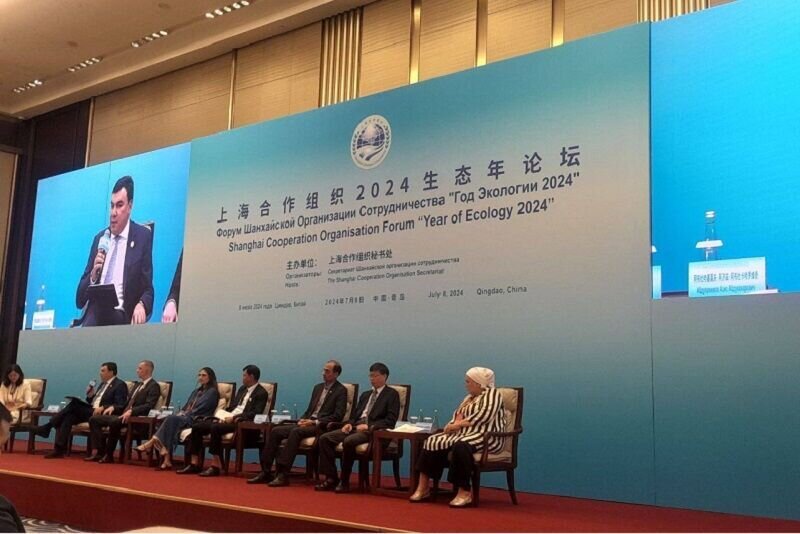Iran presents five proposals at Green Development Forum

TEHRAN – Hasan Akbari, the deputy head of the Department of Environment, presented five proposals for the preservation of biodiversity at the Green Development Forum of the Shanghai Cooperation Organization (SCO) which was held in Qingdao, China, from July 8 to 9.
“Iran is open to exchange experiences and expertise with member states of the SCO in management of protected areas and the restoration of endangered species through bilateral or multilateral cooperation,” IRNA quoted Akbari as saying.
The second proposal entails each member state focusing on a specific challenge regarding the protection of biodiversity, such as the restoration of endangered species, invasive species control, and fire management. It requests each member state to be a pioneer in solving environment-related challenges and share their experiences and knowledge with other members in upcoming meetings.
The third proposal requires the SCO to facilitate the exchange of endangered species across their distribution range among member states as a way to boost their population and prevent the loss of genetic diversity.
Establishing a biodiversity protection committee under the supervision of the SCO and holding expert meetings; developing action plans to prevent species extinction; as well as addressing the main challenges of biodiversity protection; promoting and encouraging member states to exchange knowledge, especially in using high-tech strategies for the protection and monitoring of biodiversity were the fourth and fifth methods outlined by Akbari.
The Iranian official went on to elaborate on Iran’s biodiversity and the measures taken to conserve the environment.
“There are 209 species of mammals, 563 species of birds, 275 species of reptiles, 23 species of amphibians, 320 species of freshwater fish, and 807 species of marine fish, about 20 percent of them are native, and 8600 plant species, with 1727 species endemic, registered in the country,” he noted.
Caspian Hyrcanian forests and Persian Gulf coral reefs in Iran feature a wide range of ecosystems, species, and genetic diversity.
Wetlands in Iran are of global importance for hosting migratory birds; the central steppes are home to the endangered Asiatic cheetah; the Alborz and Zagros ranges are also important national biodiversity centers that form part of two global biodiversity hotspots, that is the Caucasus and Irano-Anatolian hotspots, Akbari stated.
Unfortunately, the valuable biodiversity in Iran, like other countries, faces serious threats such as land-use change, drought, fire, agricultural activities, overgrazing, invasive non-native species, deforestation, pests, wildlife trafficking, wildlife diseases, and climate change. The non-green development has led to habitat fragmentation and significant genetic reduction, Akbari highlighted.
According to Article 50 of the Constitution, environmental protection is deemed a public duty in order to safeguard the quality of life for both the present and future generations, and any activities that cause irreparable damage to the environment are prohibited.
The Law on Protection and Improvement of the Environment and the Law on Hunting and Fishing deal with environment and biodiversity issues, and the use and protection of genetic resources.
The laws have determined and defined four types of protected areas, including national parks, national natural monuments, and wildlife sanctuaries, the official stressed.
To address these threats, Iran has managed about 12 percent of the country's land, equal to 19.5 million hectares, in the form of protected areas to minimize land-use change.
Moreover, over the past 10 years, the budget allocated to biodiversity protection has increased by 30 percent annually.
Out of 324 protected areas in Iran, a comprehensive conservation plan has been developed for 230 areas which is being implemented.
Furthermore, the Department of Environment has developed action plans for the conservation of 25 endangered species which are being implemented in the country.
The restoration of endangered animal species such as the Persian yellow deer, jebeer gazelle, the Persian zebra, and the Asiatic cheetah by increasing their population through habitat protection are among the country's successful measures in recent years.
Iran joined the international census of wintering water birds as the first West Asian country at the same time as European countries in 1976.
Encompassing numerous wetlands, reservoirs, and diverse water bodies, Iran welcomes millions of migratory birds every year. It is a wintering home for more than 1.8 million birds which is equivalent to more than five percent of the world's migratory birds.
Akbari underscored that public education, increasing public participation, and community involvement in the preservation of the environment, especially biodiversity, as well as the engagement of the private sector in protecting habitats and biodiversity preservation, are other parts of successful measures of Iran.
For example, public participation was employed to manage 260,000 hectares of mountainous lands in the form of five private reserves. Consequently, the population of key wildlife species has increased more than threefold in a 10-year period.
Ali Salajeqeh, the head of the Department of Environment (DOE), led the Iranian delegation to the Green Development Forum.
During the two-day event, Salajeqeh also delivered a speech and announced that utilizing the potential of the Shanghai Cooperation Organization’s (SCO) members is essential for fostering green development in the region and establishing a global role model for environmental cooperation.
“The Shanghai Cooperation Organization meeting provides an opportunity to develop effective and proper measures for addressing common and regional challenges and preserve the environment and green development,” IRNA quoted Salajeqeh as saying.
MT/MG
Photo: Hassan Akbari (3rd from right) is among the officials who delivered a speech at the Green Development Forum.

Leave a Comment